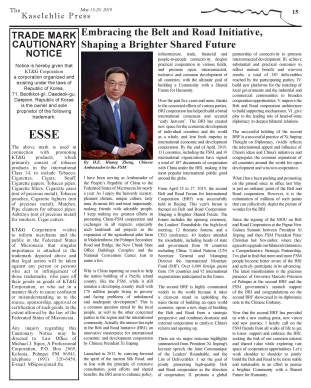On May 13th, 2019, the Kaselehlie Press, the renowned newspaper in the FSM, published, in its Vol. 19 and Iss. 11, an article by H.E. Huang Zheng, Chinese Ambassador to the FSM, titled Embracing the Belt and Road Initiative, Shaping a Brighter Shared Future. Below is its full text:

I have been serving as Ambassador of the People's Republic of China to the Federated States of Micronesia for nearly a year. As I enjoy the heavenly scenery, pleasant climate, unique culture, tasty tuna, dynamic life and most importantly, making friends with adorable people, I keep making my greatest efforts in promoting China-FSM cooperation and exchanges in all respects, especially such landmark aid projects as the expansion of the agricultural pilot farm in Madolenihmw, the Pohnpei Secondary Road and Bridge, the New Chuuk State Office Buildings Complex and the National Convention Center. Just to name a few.
Why is China inputting so much to help the nation building of a Pacific island country, like the FSM, while it still remains a developing country itself with 170 million people living in poverty and facing problems of unbalanced and inadequate development? This is a common question raised by the local people, as well as the other concerned parties in the region and the international community. Actually, the answer lies right in the Belt and Road Initiative (BRI), an innovative masterpiece for international economic and development cooperation by Chinese President Xi Jinping.
Launched in 2013, by carrying forward the spirit of the ancient Silk Road, and in line with the principle of extensive consultation, joint efforts and shared benefits, the BRI aims to enhance policy, infrastructure, trade, financial and people-to-people connectivity, deepen practical cooperation in various fields, and promote open, interconnected, inclusive and common development of all countries, with the ultimate goal of building a Community with a Shared Future for Humanity.
Over the past five years and more, thanks to the concerted efforts of various parties, BRI cooperation has helped build a broad international consensus and secured "early harvests". The BRI has created new space for the economic development of individual countries and the world as a whole, and lent fresh impetus to international economic and development cooperation. By the end of April, 2019, 131 countries, including the FSM, and 30 international organizations have signed a total of 187 documents of cooperation with China under the BRI, making it the most popular international public good around the globe.
From April 25 to 27, 2019, the second Belt and Road Forum for International Cooperation (BRF) was successfully held in Beijing. This year's forum is themed on Belt and Road Cooperation: Shaping a Brighter Shared Future. The forum includes the opening ceremony, the Leaders' Roundtable, the high-level meeting, 12 thematic forums, and a CEO conference. 40 leaders attended the roundtable, including heads of state and government from 38 countries including China, United Nations (UN) Secretary General and Managing Director the International Monetary Fund (IMF). Over 6,000 foreign guests from 150 countries and 92 international organizations participated in the forum.
The second BRF is highly commented widely in the world because it takes a clear-cut stand in upholding the main theme of building an open world economy, opens a new stage of building the Belt and Road from a strategic perspective and combines domestic and external cooperation to catalyze China's reform and opening up.
There are six major outcome highlights summarized from President Xi Jinping's keynote speech, the Joint Communique of the Leaders' Roundtable, and the List of Deliverables: I. set the goal of jointly promoting high-quality Belt and Road cooperation as the direction of cooperation; II. promote a global partnership of connectivity to promote interconnected development; III. achieve substantial and practical outcomes to reflect mutual benefit and win-win results, a total of 283 deliverables reached by the participating parties; IV. build new platforms for the matchup of local governments and the industrial and commercial communities to broaden cooperation opportunities; V. improve the Belt and Road cooperation architecture to build supporting mechanisms; VI. give play to the leading role of head-of-state diplomacy to deepen bilateral relations.
The successful holding of the second BRF is a successful practice of Xi Jinping Thought on Diplomacy, vividly reflects the international appeal and influence of China's ideas and China's initiatives and congregates the common aspirations of all countries around the world for open development and win-win cooperation.
What I have been pushing and promoting on the ground since in office last May is just an ordinary paint of the Belt and Road cooperation. However, it is the culmination of millions of such paints that can collectively depict the picture of wonder for the BRI.
Since the signing of the MOU on Belt and Road Cooperation at the Papua New Guinea Summit between President Xi Jinping and then FSM President Peter Christian last November, where they agreed to upgrade our bilateral relations to a Comprehensive Strategic Partnership, I'm glad to find that more and more FSM people become better aware of the BRI and actively participate in its advancing. The latest manifestation is the gracious presence of Governor Marcelo Peterson of Pohnpei at the second BRF and the FSM government's staunch support of the BRI and congratulations on the second BRF showcased in its diplomatic note to the Chinese Embassy.
Now that the second BRF has provided us with a new starting point, new vision and new journey, I hereby call on the FSM friends from all walks of life to get to know, support and embrace the BRI, seeking the link of our common interest and shared value while exploring vast space of cooperation opportunities. Let's work shoulder to shoulder to jointly build the Belt and Road to be more stable and sustainable in an effort to pursue a brighter Community with a Shared Future for Humanity.